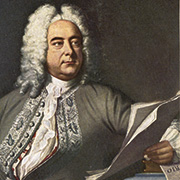Handel and his librettist Samuel Humphreys fashioned the exciting Old Testament story of Queen Esther into an equally exciting oratorio full of high points. Esther is now available in an Urtext edition from the HHA.
In 1718 Handel began work on the composition of his first English oratorio Esther HWV 50a. He chose as his subject the biblical figure of Esther from the Old Testament book of the same name. The libretto in six scenes is based on Esther, or Faith Triumphant. A sacred tragedy by Thomas Brereton (Oxford 1715), which was in turn based on the tragedy of Esther by Jean Racine (1718). By 1720 at the latest the work was performed privately at Cannons, then again at the beginning of 1732 under Bernard Gates. Perhaps it was this performance which inspired Handel to revise Esther (HWV 50b).
Esther is the consort of the Persian king Assuerus. She is very beautiful, and has concealed her Jewish descent at the behest of her foster-father Mordecai. Mordecai witnesses how two doorkeepers plot to murder Assuerus and warns him of this through Esther. Assuerus elevates Haman to become the most powerful man after the King, and all princes have to bow before him. Because he is a Jew, Mordecai refuses to obey this command. As a result, Haman enacts a law to destroy all Jews. They complain, and Mordecai commands Esther to intercede with the King on behalf of her people. However, according to the law anyone who goes before the King uninvited must die unless the King holds out his golden sceptre towards them. Mordecai responds to Esther’s objection by saying that she should not believe she is the only one amongst the Jews who is able to save her own life. As a result, she decides to go to the King. She finds grace and invites Assuerus and Haman to a banquet. Esther begs for her life and that of her people. Haman is exposed and beseeches Esther in vain for his life. He is hung, but Mordecai is honoured for his services and put in Haman’s place. At the end all praise God for their salvation.
Samuel Humphreys wrote a new libretto. He used a large portion of the text, inserted an introductory scene into the plot and fashioned three acts out of this which corresponded with the plot structure of an opera.
Handel composed new music, but a revision would have been necessary anyway because he had a different ensemble at his disposal in London. As well as that, he saw an opportunity to re-use the Coronation Anthems of 1727. He wrote most of the newly-composed movements at the end of the autograph manuscript, and there were also instructions for the copyists about what should be inserted into the conducting score.
In Esther we find musical material from works including the oratorio La Resurrezione, the motet Silete venti, the ode Eternal source of light divine and especially the Brockes Passion. Music was taken from the latter for dramatic high points such as the duet between Esther and Assuerus “Who calls my parting soul from death” and Haman’s aria “Turn not, O Queen, thy face away”. Esther is one of four oratorios in which Handel used a harp. Two horns play in the chorus “He comes”. The final chorus “The Lord our enemy has slain” draws on the style of Purcell’s verse anthems. Fully-scored choral and orchestral sections with timpani and trumpets (and occasionally prominent solo trumpet) alternate here with long continuo-accompanied soprano solos.
Just two weeks before the performance, it was announced on 19 April 1732 that there would not be any action on the stage, but instead the theatre would be decorated for the public, and the musicians would be arranged as in the Coronation Service.
Handel performed Esther in various different seasons. The conducting score was therefore constantly adapted, many folios were replaced, and large portions of the original state of the work are now missing. The surviving sections of the original conducting score contain numerous entries for the various performances, so the editor is faced with a complicated puzzle. Chrysander understandably found it very difficult to produce a proper version of the work. He did not succeed in establishing the form of the first performance.
A pre-publication score of the version of the first performance on 2 May 1732 in the King’s Theatre Haymarket is now being published as part of the Halle Handel Edition, edited on the basis of an extensive examination of the sources. The complete HHA volume, with all the Appendices and detailed text sections, is in preparation.
Annette Landgraf
(from [t]akte 1/2017)



